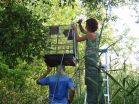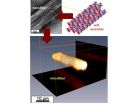(Press-News.org) URBANA, Ill. – Although it would seem logical that large numbers of roosting birds would attract more mosquitoes that carry West Nile virus and contract the disease when bitten, recent research at the University of Illinois found the opposite to be true. That is, when large groups of birds roost together the chances that an individual bird will get bitten by mosquitoes carrying West Nile virus and subsequently contract the disease actually go down.
"Our study is the first field-based evidence to support what's called the 'encounter-dilution effect' acting in a vector-borne disease system with an experiment," said U of I researcher Bethany Krebs. "There have been other laboratory and modeling studies that suggest that mosquitoes feed less per individual in a group than they do on a solitary bird but it's hard to get the information in natural settings."
The experiment was conducted over a period of three years. "We trapped mosquitoes inside and outside of roosts from 2010 to 2012 to determine whether roosts attracted more mosquitoes than non-roost sites," Krebs said. "Then we sent the mosquitoes to a lab in Texas that ran analyses on them to determine if they carried the virus. Uninfected house sparrows were used as sentinel birds to assess host risk of West Nile exposure in 2012—the timing coincided with the historical period of peak West Nile virus transmission in the Chicago study areas known to be 'hot spots' for the disease."
The house sparrows were placed in flight cages—23 birds in cages near communal roosts and 25 in non-roost cages. Krebs explained that sentinel birds are used by public health departments as sort of a "canary-in-the-coal mine" early warning system to detect the presence of a vector-borne disease.
"Only three sparrows near roosts contracted West Nile virus whereas 11 birds in non-roost cages were infected," Krebs said. "So the risk of West Nile virus exposure for those sentinel birds caged within roosts was significantly lower than for birds caged in non-roost locations."
Jeff Brawn, U of I ecologist and department head of the Natural Resources and Environmental Sciences, described how this study sheds light on the spread of vector-borne diseases, such as West Nile virus, compared to those transmitted via direct contact. "If you're in a group, the probability of infection goes way up with direct contact diseases such as colds and flu," Brawn explained. "This study confirmed that the risk is spread out among the individuals in the herd; in the case of West Nile virus, which is a vector-borne disease, individual risk is minimized."
Brawn said that they don't understand why some birds roost and others of the same species do not. But this study shows that those who do choose to roost together benefit by the lower risk of exposure to West Nile virus infection.
The maintenance and transmission of West Nile virus goes something like this: The common mosquito Culex pipiens is the carrier (vector) of the disease. The mosquitoes bite birds, usually at night while they are roosting and infect them with the virus. Crows and jays typically die after they contract West Nile virus, but robins are called "super-amplifiers of the disease." They are able to serve as hosts for the virus. Later, other mosquitoes bite the infected birds, get the virus, and transmit it to another host—which could be another bird or a human.
This brings to a close almost 10 years of research on West Nile virus in the Chicago area supported by funding from the National Science Foundation. "This was the last year that we were planning to do significant field work in that area of Chicago," Krebs said.
Brawn said that a study like this that has many components also requires experts from many disciplines. "It can only happen when you have field biologists, mosquito specialists, disease experts, epidemiologists–that team of researchers that worked on this project is multi-faceted. That's what it takes to do this kind of work. We collected blood samples from the birds and sent those to be analyzed. We sent the mosquitoes to someone else who knew how to do all of the genetic analysis. It's a team working together."
Brawn added that, although the study was on birds, it could provide an interesting implication with respect to human behavior and health risk. "If you are in the woods alone, you may have a greater probability of getting bitten than if you are in a large group of people," he said.
INFORMATION:
"Host group formation decreases exposure to vector-borne disease: a field experiment in a 'hotspot' of West Nile virus transmission" was written by Bethany L. Krebs, Marilyn O. Ruiz, and Jeffrey D. Brawn from the University of Illinois; Tavis K. Anderson from Georgia Southern University; Tony L. Goldberg and Christina M. Newman from the University of Wisconsin; Gabriel L. Hamer from Texas A&M; Uriel D. Kitron from Emory University; and Edward D. Walker from Michigan State University. The research was published in the Proceedings of the Royal Society B: Biological Sciences and was supported by the National Science Foundation Ecology of Infectious Disease program.
COLUMBUS, Ohio: Astronomers have gotten the closest look yet at what happens when a black hole takes a bite out of a star—and the star lives to tell the tale.
We may think of black holes as swallowing entire stars—or any other object that wanders too close to their immense gravity. But sometimes, a star that is almost captured by a black hole escapes with only a portion of its mass torn off. Such was the case for a star some 650 million light years away toward Ursa Major, the constellation that contains the "Big Dipper," where a supermassive black hole tore ...
Using a technique that illuminates subtle changes in individual proteins, chemistry researchers at Cornell University have uncovered new insight into the underlying causes of Amyotrophic Lateral Sclerosis (ALS).
Brian Crane, professor of chemistry and chemical biology, led one study and co-authored a follow-up on a spectroscopic method that detects subtle changes to copper-containing proteins in solution. He and Jack Freed, professor of physical chemistry, have developed the method together with Petr Borbat, associate director of Cornell's National Biomedical Center for ...
ITHACA, N.Y. – To solve a mental puzzle, the brain's executive control network for externally focused, goal-oriented thinking must activate, while the network for internally directed thinking like daydreaming must be turned down to avoid interference – or so we thought.
New research led by Cornell University neuroscientist Nathan Spreng shows for the first time that engaging brain areas linked to so-called "off-task" mental activities (such as mind-wandering and reminiscing) can actually boost performance on some challenging mental tasks. The results advance ...
Researchers at the New York University Polytechnic School of Engineering have broken new ground in the development of proteins that form specialized fibers used in medicine and nanotechnology. For as long as scientists have been able to create new proteins that are capable of self-assembling into fibers, their work has taken place on the nanoscale. For the first time, this achievement has been realized on the microscale—a leap of magnitude in size that presents significant new opportunities for using engineered protein fibers.
Jin Kim Montclare, an associate professor ...
In this image taken by the Aqua satellite of the southern United States actively burning areas as detected by MODIS's thermal bands are outlined in red. Each red hot spot is an area where the thermal detectors on the MODIS instrument recognized temperatures higher than background. When accompanied by plumes of smoke, as in this image, such hot spots are diagnostic for fire. These fires are a combination of small wildfires and prescribed fires. On the U.S. Forest Service website a prescribed fire is set to reduce tree overcrowding, revive fire-dependent species and reduce ...
Despite a dramatic increase in public awareness and anti-bullying legislation nationwide, the prevalence of bullying is still one of the most pressing issues facing our nation's youth, according to a report by researchers from Clemson University and Professional Data Analysts Inc., and published by the Hazelden Foundation.
"Bullying continues to affect a great number of children in all age groups, with the highest prevalence observed in third and fourth grades, where roughly 22 percent of schoolchildren report that they are bullied two or three times or more per month," ...
A new test, developed by University of British Columbia researchers, could help physicians predict within an hour if a patient will develop severe sepsis so they can begin treatment immediately.
Sepsis, a syndrome caused by infection, leads to organ failure and is responsible for up to five million deaths annually. There are 18 million cases of sepsis worldwide every year.
The discovery could cut back on the lengthy diagnostic time usually required to confirm if a patient is suffering from sepsis and increase the odds that they will respond to treatment.
"We identified ...
Scientists have found a molecule that could potentially accelerate clinical trials to combat autoimmune diseases.
Researchers from the Australian Regenerative Medicine Institute (ARMI) at Monash University and the European Molecular Biology Laboratory (EMBL) in Italy believe the molecule, called insulin-like growth factor-1 (IGF-1), could play a key role.
Autoimmune diseases occur when a group of immune cells called pro-inflammatory T-effector cells become sensitised to specific cells in the body, identifying them as foreign and attacking them as if they were invading ...
Sediments associated with dredging and flood plumes could have a significant impact on fish populations by extending the time required for the development of their larvae, according to Australian researchers.
"Sediment concentrations at levels found in plumes from dredging or in floods cause a significant delay in the development of clownfish larvae," says study lead author, Dr Amelia Wenger, from the ARC Centre of Excellence for Coral Reef Studies (Coral CoE) at James Cook University.
"This in turn could significantly reduce the numbers of larvae competent to settle ...
Loggerhead turtles (Caretta caretta) from Cape Verde start their life with a swimming sprint and a ride on favourable ocean currents. In this way, they escape quickly from predator-rich coastal areas and make their way to the safer open ocean where they spend several years feeding and growing. In this study, tiny acoustic transmitters provided direct insight into these pathways for the first time. "Thanks to the new technology we can start to fill in key information gaps about the so-called 'lost years' Dr. Rebecca Scott states. Funded by the Kiel Cluster of Excellence ...



